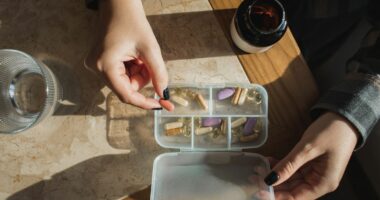Share this @internewscast.com
Robert F Kennedy Jr notched another victory in his ‘Make America Healthy Again’ war against food dyes – but it seems Big Candy is not as sweet on his crusade.
Last week, some of the nation’s biggest ice cream producers agreed to voluntarily phase out artificial food coloring – which the US Health Secretary has claimed is linked to neurobehavioral problems in children, cancer and the chronic disease epidemic in America.
But Mars — the maker of M&M’s, Snickers and Skittles — is standing firm against the public pressure campaign.
The candymaker has claimed that customers are indifferent to synthetic coloring, per internal research from 2020 that suggested candy is immune from the American desire for natural ingredients.
As a result, the company is refusing to remove artificial colors from its products in certain markets, according to a statement on its site.
They might want to reconsider that stance. A new Daily Mail poll says most Americans are opposed to the use of synthetic food dyes.
The survey of more than 1,000 registered voters, conducted July 9 and 10, found that more than half of Americans believe food dyes are dangerous.
Nearly half agree that food dyes cause cancer, more than eight in 10 support warning labels for dyes, and over half support banning food dyes entirely.

Robert F Kennedy Jr notched another victory in his ‘Make America Healthy Again’ war against food dyes.

Last week, the International Dairy Foods Association, alongside federal health officials, announced that the ice cream giants responsible for churning out a majority of the nation’s frozen desserts have vowed to stop using artificial dyes.
‘The Daily Mail’s data is in line with what we’re seeing and hearing from consumers,’ Kyle Diamantas, the US Food and Drug Administration Deputy Commissioner for Human Foods, told the Daily Mail.
Mars’s 2020 figures are dated, he said – and customers have almost ‘certainly’ changed their stance in the five years since that survey was conducted.
‘Consumers absolutely are demanding this change,’ he said.
Indeed, consumers overseas influenced synthetic food dye regulations years ago. In 2010, the European Union began requiring labels on foods containing certain dyes, warning they could trigger hyperactivity in children.
In Europe, Nestle’s Smarties get their pastel hues from radishes, lemons, and red cabbage extracts. As for M&Ms, vegetable-derived dyes are used due to bans on artificial dyes – such as Yellow 5, Yellow 6, and Red 40 – in certain European countries.
‘Now when European consumers see an American piece of candy, they say, “Oh, that looks fake, it looks like it’s glowing,”‘ Diamantas said.
‘Here, you’re seeing more and more consumers that don’t want that vibrant, bright red or neon green. We are quickly moving to a view of an actual-colored product.’
Last week, the International Dairy Foods Association, alongside federal health officials, announced that the ice cream giants responsible for churning out a majority of the nation’s frozen desserts have vowed to stop using artificial dyes.
Approximately 40 companies pledged to eliminate seven petroleum-based dyes – Red 3, Red 40, Green 3, Blue 1, Blue 2, Yellow 5, and Yellow 6 – from their products by 2027.
Companies including Nestle, Kraft Heinz and General Mills said they, too, would pull artificial colors from their foods, and Hershey recently announced it would remove artificial dyes in its confections by the end of 2027.
Mondelez, another of the nation’s top candy companies that produces Oreos, also said it will work to reformulate its US products.
But critics are not convinced about the efficacy of the campaign against food dyes.
While the focus on synthetic coloring is ‘a good step to take,’ University of Texas nutrition expert Deanna Hoelscher told the Daily Mail that officials should not ignore larger known contributors to chronic disease, including the added sugars and saturated fat commonly found in ice cream.
And there’s skepticism over whether the manufacturers who have pledged to voluntarily remove the dyes will follow through on their promises.
‘Talk is cheap,’ said Thomas Galligan, a scientist with the Center for Science in the Public Interest, a consumer advocacy group. ‘It’s easy for companies to make promises to look like they’re being compliant and generate goodwill among consumers and the Trump administration, but it remains to be seen if they will actually follow through.’
Diamantas said the FDA is in ‘active dialogue’ with Mars, but warned that failure to comply with updated guidance could push the agency to ban certain dyes.
‘We came out of the gate on the voluntary abandonment approach because it’s the quickest way to coalesce action on this, and it’s been a tremendous success,’ he said. ‘That doesn’t mean we don’t have other tools…. The FDA can reassess the safety and science of ingredients that are currently lawful in food supply.
The agency already ordered a ban on Red 3 in January over concerns of cancer, ordering for it to be removed from foods sold in the US by 2027 and medications by 2028, and some states are seeking a ban on Red 40, or Allura red.
Meanwhile they have sanctioned the use of new, natural color additives and this week announced their approval of a blue made from the fruit of the gardenia’s use in sports drinks, candies, and other products.
But while more natural options for food coloring are becoming available, key holdouts remain, including Mars’ subsidiary Kellogg’s, whose Froot Loops still use Red 40, Yellow 5, Blue 1, and Yellow 6 in the US, despite the same cereal not containing artificial dyes in places like Canada.

Mars — the maker of M&M’s, Snickers and Skittles — is standing firm against the public pressure campaign.

Kellogg’s Froot Loops still use Red 40, Yellow 5, Blue 1, and Yellow 6 in the US, despite the same cereal not containing artificial dyes in places like Canada.
Mars declined the Daily Mail’s request to comment, but National Confectioners Association representative Christopher Gindlesperger spoke on its behalf. He said that a rush to switch to natural dyes could cause prices to spike due to a lack of sufficient supply.
‘The companies that make natural colors simply don’t make enough to meet demand,’ Gindlesperger told the Daily Mail. ‘You don’t have to be an economist to know that when supply is low and demand is high, prices skyrocket – and that’s what many anticipate will happen to these alternative ingredients without an adequate transition period.’
He also suggested that the research into consumers’ views on food dyes may not extend to their expectations for the ingredients in their candy.
He said, ‘People have a unique mindset when they enjoy chocolate and candy that is not present when interacting with other foods.’
The snack industry, he added, is ‘in firm agreement that science-based evaluation of food additives will help eliminate consumer confusion and rebuild trust in our national food safety system.’
Speaking on behalf of the FDA Diamantas said, ‘We’re very confident that companies will continue to address this call because their consumers are demanding it and because it’s the right thing to do for the American people.’












